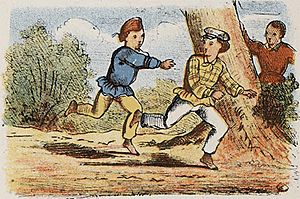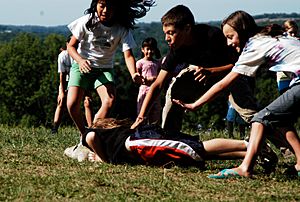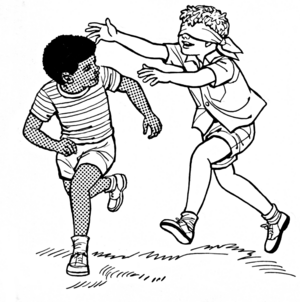Tag (game) facts for kids
Tag is a super fun game where players chase each other. The goal is to "tag" or touch someone, usually with your hand. You might also hear it called "it" or "tig." Most versions of Tag don't need teams, scores, or special equipment. When you tag someone, you often shout, "Tag, you're it!"
Contents
How to Play Tag: Basic Rules
To start, a group of two or more players decides who will be "it." This is often done with a counting-out game like eeny, meeny, miny, moe.
The player who is "it" then chases the other players. Their goal is to get close enough to "tag" someone by touching them with a hand. The other players try to run away and avoid being tagged.
When a player is tagged, they become the new "it." In some games, the old "it" is no longer "it." The game can keep going forever! In other versions, both players stay "it." The game ends when everyone has been tagged.
There are many ways to play Tag. Some versions make it an elimination game. If you're tagged, you're out! Other rules stop a player from tagging the person who just tagged them. This is called "no tags-back" or "can't tag your master."
Safe Zones and Truce Words
Sometimes, players can be safe from being tagged. This happens if they are in a special area or touching a certain object. For example, in "Wood Tag," you are safe if you touch wood. Other safe spots are called "base," "home," or "den."
Players can also use a special word to become safe. This is called a truce term.
Different Ways to Play Tag: Fun Variants
British Bulldogs: A Chasing Challenge
"British Bulldogs" is a popular game, especially in the United Kingdom and Canada. One or two players start as the "bulldogs" in the middle of the play area. The other players stand at one end.
The goal is to run from one end to the other without being caught by the bulldogs. If a bulldog catches you, you become a bulldog too! The last player who isn't caught wins the game. This game is also known as "Sharks and Minnows."
Chain Tag: Grow Your Team!
In Chain Tag, when someone is caught, they join hands with the person who is "it." This forms a chain. The chain then chases the other players together.
As more people are caught, the chain gets longer and longer. Only the players at the ends of the chain can tag someone because they have a free hand. This game is also called "Blob" or "Gargon."
Duck, Duck, Goose: A Classic for Little Ones
This game is usually played by younger children. Players sit in a circle facing each other. One player, the "picker," walks around the circle. They tap each player, calling them a "duck."
Then, the picker chooses one player and calls them the "goose." The goose quickly stands up and runs around the circle. They try to get back to their seat before the picker can sit down in it. In Minnesota, this game is called "Duck, Duck, Gray Duck."
Freeze Tag: Stuck in the Mud!
Freeze Tag is also known as "Stuck in the Mud." If you get tagged, you are "frozen" and must stand still with your arms out. Another player who isn't frozen can unfreeze you. They might tag you, crawl between your legs, or "flush" you by hitting your outstretched hand. The last person not frozen usually becomes "it" for the next game.
Last Tag: The Goodbye Game
Last Tag was played a long time ago, especially when kids were leaving school for home. A player would tag someone and make them "it" right before they left. The rule was: no tagging back! It was important not to be the one left with the "last tag." If you couldn't tag anyone, you became "it" the next day.
Octopus Tag: The Ocean Chase
Octopus tag is a mix of Tag and another game called Red Rover. One player is the "octopus" and tries to tag the others. The playing area is called the "ocean." The other players, or "fish," line up on one side of the ocean.
When the Octopus shouts, "Come fishies come!", the fish try to run to the other side without getting tagged. If a fish gets tagged, they become "seaweed." They must freeze where they were tagged but can wave their arms to help the Octopus tag other fish within reach. The last fish to be tagged becomes the next Octopus.
Shipwrecked: Finding Safe Spots
In Shipwrecked, one player is "it" and tries to tag the others. There are safe zones, like circles, but there's always one fewer safe zone than there are players. You can't enter a safe zone if someone else is already in it. If you get tagged, you become "it."
Team Tag: Working Together
Manhunt: Hide and Seek with a Twist
Manhunt combines hide and seek with Tag. It's often played at night. One person is "it," and the other players hide. The "it" player then tries to find and tag them. The game ends when everyone has been found and tagged.
Manhunt can also be played with teams. In some versions, there's a home base where players are safe. That game ends when all players who are not safe are out.
What's the Time, Mr Wolf?: A Stepping Game
One player is chosen to be Mr Wolf. They stand facing away from the other players at the far end of the playing field. The other players all chant, "What's the time, Mr Wolf?"
Mr Wolf can answer in two ways:
- Mr Wolf can call a time, like "Three o'clock!" The other players take that many steps towards Mr Wolf. Then they ask the question again.
- Mr Wolf can shout, "Dinner time!" and quickly turn around. Mr Wolf then chases the other players back to their starting point. If Mr Wolf tags a player, that player becomes Mr Wolf for the next round.
Ringolevio: Team Jailbreak
In Ringolevio, there are two teams. In one version, one team hides, and the other team counts to a number like 30 before looking for them. In another version, each team has its own "jail," like a park bench. The game continues until all players from one team are in jail.
Tag Games with Equipment
Some types of Tag use special equipment instead of just hands for tagging. This can include balls, flashlights, or even special guns.
Blind Man's Bluff: Tagging Blindfolded
Blind Man's Bluff is a version of Tag where one player, who is "it," wears a blindfold. They try to tag the other players while being unable to see them. The other players try to avoid being tagged.
Flashlight Tag: Nighttime Fun
Flashlight Tag, also called "Spotlight," is played at night. Instead of touching someone, the "it" player tags others by shining a flashlight beam on them.
Kick the Can: Freeing Friends
In Kick the Can, one person is "it," and a can is placed in an open area. The other players run and hide. "It" then tries to find and tag each of them. Tagged players are sent to a "jail." Any player who hasn't been caught can kick the can, which sets all the jailed players free!
Laser Tag: High-Tech Tagging
Laser Tag is like Flashlight Tag but uses special equipment. Players carry guns that shoot beams of light. They also wear electronic gear that can sense when they've been "hit" by a beam. This equipment often keeps score and adds fun penalties for getting hit. Many places have special arenas where you can play Laser Tag.
Paintball: Colorful Hits
Paintball is a sport where players use special guns called paintball markers. These guns shoot pellets filled with paint to tag other players. Paintball games are usually played on special fields with strict safety rules.
Sock Tag: Flour Power!
In Sock Tag, you fill the toe of a tube sock with a little bit of flour. You hold the sock by the open end and swing it like a flail. If you hit another player with any part of the sock, it counts as a tag!
Spud: Catch and Throw
Spud is a Tag game best played in a large, open area. All players start in the middle. The person who is "it" throws a ball high into the air. The other players run away.
As soon as "it" catches the ball, they shout "Spud!" Everyone else must stop running. "It" can then take three big steps towards any player they choose. Then, "it" throws the ball at that player. If the ball hits the target, that player becomes "it," and the game starts over.
See also
 In Spanish: Juego de persecución para niños
In Spanish: Juego de persecución para niños





